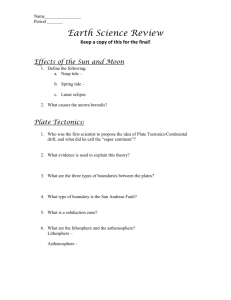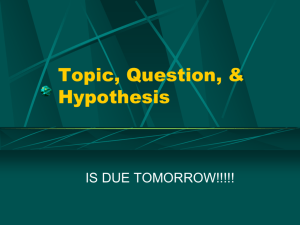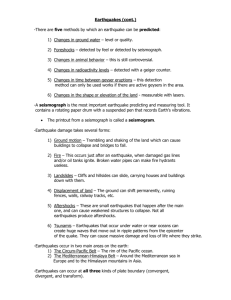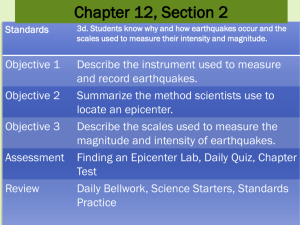ESSA_13
advertisement
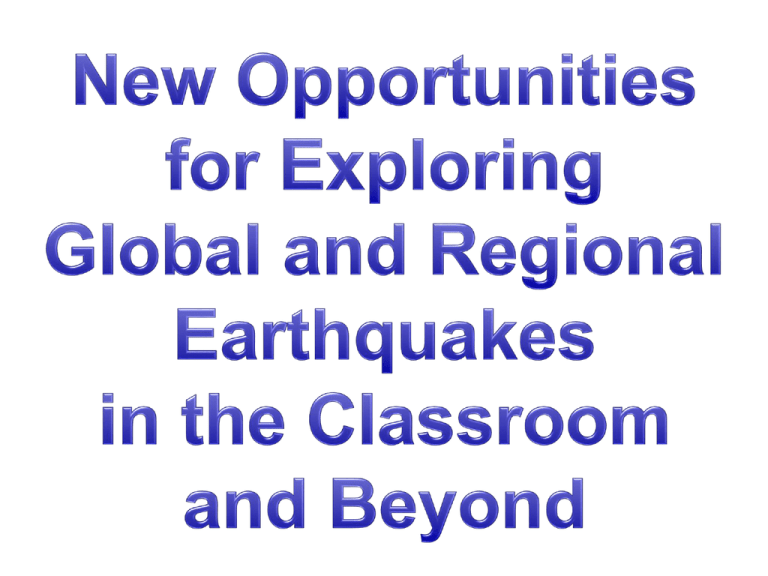
Alan Kafka, Justin Starr, Anastasia Moulis Weston Observatory Department of Earth and Environmental Sciences Boston College Tammy Bravo IRIS Consortium Ben Coleman Department of Computer Science Moravian College John Taber IRIS Consortium What (and Where) is an Earthquake Observatory in the 21st Century? In the early 1900s, an earthquake observatory was a building housing seismographs. Now the concept of an earthquake observatory has evolved into much more than “bricks and mortar” - it is a distributed network for earthquake monitoring and research, and for providing educational and public outreach resources about all aspects of the science of seismology and earthquake hazards. We are experimenting with different ways to present seismograms and other earthquake information to optimize the dissemination of information for the many different audiences that are served by the earthquake observatory of the 21st Century. What (and Where) is an Earthquake Observatory in the 21st Century? Mid1900s 2013 and beyond… Weston Observatory in the 21st Century... Seismology Research • • • • Earthquakes Monitoring Planet Earth Earth’s Interior Earth Processes Science Education Public Outreach Science Education and Public Outreach Through Seismology The Earthquake Observatory of the 21st Century is a variety of things to a variety of people: People feel earthquakes & are concerned about their effects. People find out about earthquakes through news media & want the observatory to be a reliable resource to explain what happened. Students record earthquakes with seismographs in schools. Research seismologists record earthquakes in unprecedented ways & new earthquakes inform advances in research on a daily basis. Earthquakes sometimes change the political landscape (such as Fukushima nuclear disaster…) Large earthquakes are regional, and sometimes global, social events. And, more... Fukushima’s Fallout: The Half-Lives of Nuclear Refugees October 3, 2013 To this day, the plant still leaks toxic, radioactive water and tens of thousands of “nuclear refugees” from nearby towns are still outcasts in their own lands. Seismological observatories operate a variety of types of seismographs, each “tuned in” to some aspect of watching the Earth quake. We monitor earthquakes recorded by “research seismographs” and by “educational seismographs” in schools and other publicly accessible locations. Seismographs in classrooms, and other publicly accessible locations, give students of all ages direct experience with recording earthquakes. But these inexpensive educational seismographs are limited in terms of their quality of seismic recording compared to what can be achieved with much more expensive research seismographs. A new development is now enabling us to integrate these two aspects of our seismic recording. New software (currently in beta testing) called jAmaSeis, being developed by Incorporated Research Institutions for Seismology, in collaboration with Moravian College, makes it possible to bring educational and research seismograph data together in the same seismogram viewing and analysis environment. jAmaSeis Boston College Sitting Bull Academy Peru, Magnitude 7.0 September 25, 2013 Devlin Hall Weston Observatory Noisy site, but direct access to seismograph. Quiet site, but remote. BC-ESP Bicoastal Quake Watchers August 10, 2013 jAmaSeis Weston, MA (WOBC) Boston College SBCA California 3.8 Magnitude 3.8 WOBC Apple Valley, CA (SBCA) Sitting Bull Academy California 3.8 3.3 Aftershock Magnitude 3.8 Earthquake: Pine Valley, California (and Magnitude 3.3 Aftershock) jAmaSeis August 4, 2013 Weston, MA (WOBC) Boston College Canada 5.3 California 3.9 SBCA Canada 5.3 WOBC Apple Valley, CA (SBCA) Sitting Bull Academy California 3.9 Canada 5.3 Boston College Educational Seismology Project Hollis Center, Maine Magnitude 4.0 October 16, 2012 16 sec 16 sec Weston Observatory Gleason Public Library Carlisle, MA Magnitude 7.0 Earthquake: Alaska, August 30, 2013 Devlin Hall, Boston College (EQ1 Educational Seismograph) Weston, MA (NESN Research Seismograph) Magnitude 7.7 September 24, 2013 Pakistan Earthquake and Aftershock: Illustration of the Concept of Magnitude Magnitude 6.8 September 28, 2013 “Touchfoil” Project: People of all ages interact with air quality data to engage in science “on the spot”... ? From: Mike Barnett Boston College Lynch School of Education Possibilities for doing the same thing with earthquakes: People of all ages could interact with seismic data to engage in science “on the spot” in schools, libraries and other public places.

